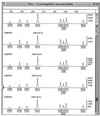Fluorescent amplified-fragment length polymorphism genotyping of Neisseria meningitidis identifies clones associated with invasive disease
- PMID: 11101599
- PMCID: PMC87640
- DOI: 10.1128/JCM.38.12.4580-4585.2000
Fluorescent amplified-fragment length polymorphism genotyping of Neisseria meningitidis identifies clones associated with invasive disease
Abstract
Fluorescent amplified-fragment length polymorphism (FAFLP), a genotyping technique with phylogenetic significance, was applied to 123 isolates of Neisseria meningitidis. Nine of these were from an outbreak in a British university; 9 were from a recent outbreak in Pontypridd, Glamorgan; 15 were from sporadic cases of meningococcal disease; 26 were from the National Collection of Type Cultures; 58 were carrier isolates from Ironville, Derbyshire; 1 was a disease isolate from Ironville; and five were representatives of invasive clones of N. meningitidis. FAFLP analysis results were compared with previously published multilocus sequence typing (MLST) and pulsed-field gel electrophoresis (PFGE) results. FAFLP was able to identify hypervirulent, hyperendemic lineages (invasive clones) of N. meningitidis as well as did MLST. PFGE did not discriminate between two strains from the outbreak that were classified as similar but distinct by FAFLP. The results suggest that high resolution of N. meningitidis for outbreak and other epidemiological analyses is more cost efficient by FAFLP than by sequencing procedures.
Figures



References
-
- Berron S, De La Fuente L, Martin E, Vazquez J A. Increasing incidence of meningococcal diseases in Spain associated with a new variant of serogroup C. Eur J Clin Microbiol Infect Dis. 1998;17:85–89. - PubMed
-
- Bevanger L, Bergh K, Gisnas G, Caugant D A, Froholm L O. Identification of nasopharyngeal carriage of an outbreak strain of Neisseria meningitidis by pulsed-field gel electrophoresis versus phenotypic methods. J Med Microbiol. 1998;47:993–998. - PubMed
-
- Caugant D A, Bovre K, Gaustad P, Bryn K, Holten E, Hoiby A, Froholm L O. Multilocus genotypes determined by enzyme electrophoresis of Neisseria meningitidis isolated from patients with systemic disease and from healthy carriers. J Gen Microbiol. 1985;132:641–652. - PubMed
MeSH terms
Substances
LinkOut - more resources
Full Text Sources
Molecular Biology Databases

